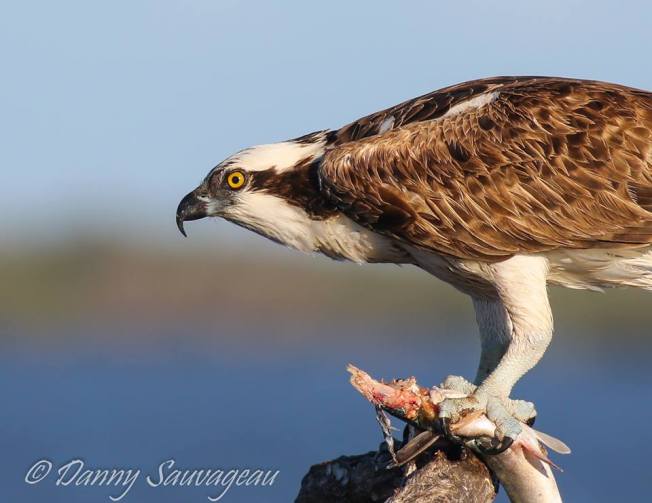OSPREY ID GUIDE: THE BAHAMAS SUBSPECIES REVISITED
I am reposting this article in the wake of a recent Bird Club of New Providence bird of prey ID query featuring distant but still helpful photos that enabled the ID as an osprey. As far as I can tell from the visible evidence (the images pixellate when enlarged) this is the ‘local’ Bahamian subspecies that differs in subtle ways from the standard North American version. Both types are found in the northern Bahamas; it would definitely be a great ‘get’ to locate one of each on the same day…
I sometimes feature bird comparatives, not least because there is so much scope for confusion that I have to keep checking for myself. Tyrant flycatchers; a number of superficially similar warbler species (all with yellow bits); those vireos; all those heron-y / egret-y types and their disconcerting morphs (hello, white reddish egret).
And so to the magnificent osprey Pandion haliaetus. This time, the comparison is between two subspecies, broadly the North American P. h. carolinensis and the Caribbean P.h. ridgwayi. There is some overlap in Florida, and some evidence of interbreeding. In the northern Bahamas in particular there is also an overlap, so an osprey seen on Abaco could be either variety. You’ll probably be too excited watching it to care much which type it is, but this article will help you if you do…
The two ospreys shown below were recently photographed at Spanish Wells, Eleuthera by Barbara Crouchley. This is a ‘bingo’ photographic scoop, because each type of bird was found in the same region; now we can check out the differences between the two birds.
The first is a North American bird. Note in particular its distinctive eye mask, and the clearly marked upper breast, more so in the female than the male (which may even be white). The overall impression of the upper-parts is dark brown. They are slightly larger than their cousins in the south.
In this Caribbean bird with its trophy fish, the eye-mask is absent, and the facial / nape markings are less pronounced. Furthermore, the breast and under-parts are white in both sexes (though slight marking may be apparent in some birds). And the impression is of lighter upper-parts, even allowing for variable lighting and distance when the photos were taken. Conveniently, there’s not much detectable difference between male and females in the respective populations.
EXAMPLES OF P. h. carolinensis
EXAMPLES OF P. h. ridgwayi
I’m going to stick my neck out here – I’ve not seen this mentioned anywhere, and I need to do some more comparative research. When I saw Barbara’s pair of photos, I immediately noticed that the eyes of the P.h.r were paler than the bright orangey-yellow of P.h.c. This distinction carries on through the comparative photos above: the P.h.cs were photographed in Florida and further north and have strikingly vivid eyes. The P.h.rs were photographed on Abaco and Grand Bahama at different times by different people. All have noticeably paler irises, more a light greeny-yellow.
I’d welcome any views on this rash amateur theory. Preferably supportive ones…
UNDERWING DIFFERENCES
There’s a further comparison that can be made with the two subspecies in flight. Without going into technical and linguistic detail, the underwings of the P.h.cs are much darker than the Bahamas birds, whereas P.h.rs are notably paler and in some cases mostly white. As an example, below is a distance shot I took when bonefishing out on the Abaco Marls, using a pocket camera. This is definitely a local bird! Compare with the dramatic image below it, where the strong darker markings are all too evident. It’s a great shot with which to bring the lesson to an end.
Photo credits: Tom Sheley (1); CWFNJ (2); Barbara Crouchley (3, 4); Danny Sauvageau (5, 6, 7); Jim Todd (8); Linda Barry Cooper (9); Woody Bracey (10); Keith Salvesen (11); the inimitable Northside Jim (12); Cute-toon, Birdorable. Thanks for all use permissions – also to Steve Connett for the idea!















Wonderful to hear about the subspecies of osprey on Abaco, RH, and fantastic photos. I am always happy to know the folks on Abaco are paying close attention.
LikeLiked by 1 person
Thanks Jet. Eyes are always focussed on the details (other people’s eyes and rather more than my own!
LikeLiked by 1 person
Very interesting post, I was not aware of your Osprey subspecies. Appreciate and thank you for sharing!
LikeLiked by 1 person
Such magnificent photos and such an amazing bird.
LikeLiked by 2 people
Thanks Cindy – it was a pleasure to put the post together, and have such great photos to work with!
LikeLiked by 1 person
Reblogged this on Wolf's Birding and Bonsai Blog.
LikeLiked by 1 person
Lovely Photo Shots 🙂 I miss the birds of prey at my 18 ft ‘hawk pole’ After a bunch of rich folks poisoned the starlings & crackles in Johnson City in east Tennessee nine years ago I have not seen a raptor in a long long time 😢 Did see this ill Juvenal ‘Broad Wing’ this spring & a ‘Red Tail’ circling high above only briefly one after noon. Those bad boys used to hang out on my pole every sun-set ten years ago 😢
👉 https://washe240347587wordpresscom.files.wordpress.com/2019/05/juvinal-cooper3apr19-2.jpg
👉 https://washe240347587wordpresscom.files.wordpress.com/2019/05/hawkpole.jpg
LikeLiked by 1 person
That’s so sad. I guess no small birds, exit predators. Thanks for the links. I’m not able to open them at the moment (on a boat) so I’ll do so in a few days!
LikeLiked by 1 person